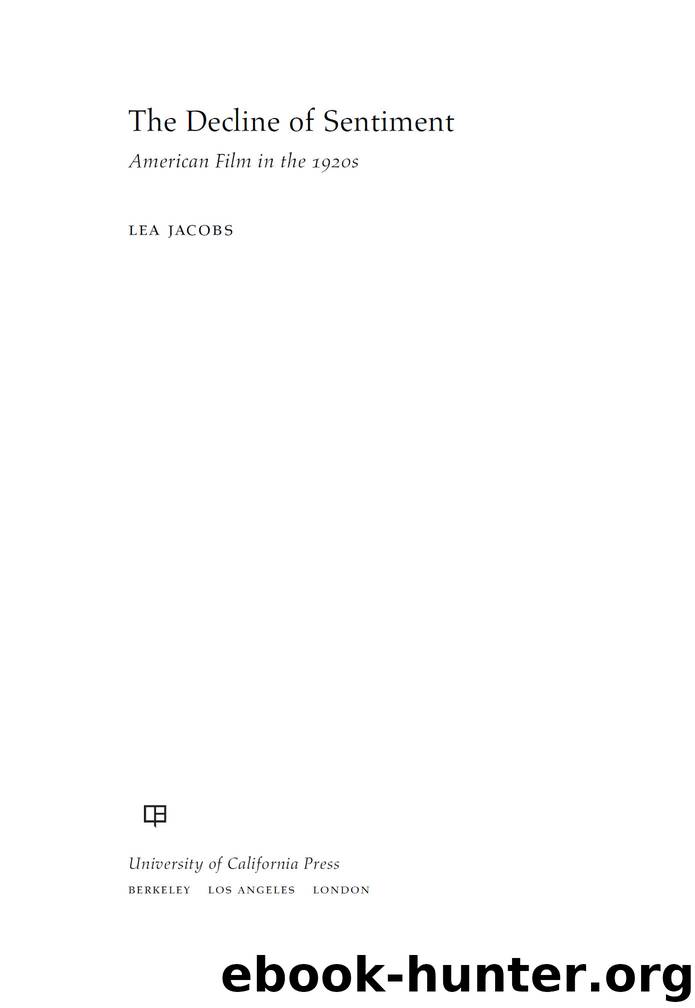The Decline of Sentiment by Jacobs Lea

Author:Jacobs, Lea
Language: eng
Format: epub
Publisher: University of California Press
Published: 2008-03-14T16:00:00+00:00
5 The Seduction Plot
It’s not ’cause I wouldn’t,
It’s not ’cause I shouldn’t,
And, lord knows, it’s not ’cause I couldn’t,
It’s simply because I’m the laziest gal in town.
“The Laziest Gal in Town,” words and
music by Cole Porter, 1927
The seduction plot was one of the cornerstones of eighteenth-century sentimental literature, the central motif of Richardson’s novels, a possibility represented from the point of view of the sensitive man of feeling in Sterne’s A Sentimental Journey and Oliver Goldsmith’s The Vicar of Wakefield, and, by the nineteenth century, a common motif of stage melodrama and the three-decker novel.1 Nonetheless, it held an ambiguous place in American nineteenth-century culture. Herbert Ross Brown has shown the enormous popularity in America of Richardson among other British writers of sentimental fiction.2 Cathy Davidson has demonstrated how Charlotte Temple, one of the first American novels and a canonical example of the story of the woman seduced and abandoned, sold widely in all sectors of the American reading public.3 But by the mid-nineteenth century, as Leslie Fiedler has remarked, quasi-pornographic descriptions of seduction attempts, such as are found in Richardson, were considered beyond the bounds of good taste. Fiedler discusses the changes in the seduction plot at the hands of what he calls “the lady purveyors of genteel, sentimental fiction,” focusing not only on the expurgation of seduction scenes but also on the introduction of narrative substitutes for the struggle with the seducer.4 Although she emphasizes somewhat different aspects of this trend, Nina Baym also argues that in the mid-nineteenth century the seduction plot became less prevalent in middle-class American fiction.5 The American sentimental novel was frequently resolved more optimistically than were novels such as Clarissa, offering its readers pragmatic edification in the story of a young heroine finding a way to survive in the world rather than the pious spectacle of a slow and moving death.
Despite its attenuation in genteel fiction, there is consensus that the seduction plot continued to be a powerful convention throughout the nineteenth century in popular theater and in fiction ranging from the stories published in penny family newspapers to such critically acclaimed novels as George Eliot’s Adam Bede and Charlotte Bronte’s Jane Eyre. Sally Mitchell has argued that by the 1880s the working-class versions of the seduction plot in British family papers eschewed the exploration of the moral, social, or psychological aspects of the seduction found in more elite novels. They tended to concentrate upon the physical conflict between the heroine and her erstwhile seducer, often having the heroine withstand literal imprisonment or attack and sometimes stressing her physical prowess.6 Popular theater also tended to represent the seduction as a physical assault upon the heroine, one from which she might or might not be saved either by her own actions or by those of others.7 In discussing the importance of this plot in American working-class fiction, Michael Denning points to the role of Laura Jean Libbey, whose works appeared frequently in the weekly story papers Fireside Companion, the New York Ledger, and Family Story Paper in the 1880s and 1890s.
Download
This site does not store any files on its server. We only index and link to content provided by other sites. Please contact the content providers to delete copyright contents if any and email us, we'll remove relevant links or contents immediately.
The Kite Runner by Khaled Hosseini(5082)
Gerald's Game by Stephen King(4574)
Dialogue by Robert McKee(4321)
The Perils of Being Moderately Famous by Soha Ali Khan(4169)
The 101 Dalmatians by Dodie Smith(3451)
Story: Substance, Structure, Style and the Principles of Screenwriting by Robert McKee(3397)
The Pixar Touch by David A. Price(3362)
Confessions of a Video Vixen by Karrine Steffans(3241)
How Music Works by David Byrne(3184)
Fantastic Beasts: The Crimes of Grindelwald by J. K. Rowling(2994)
Harry Potter 4 - Harry Potter and The Goblet of Fire by J.K.Rowling(2986)
Slugfest by Reed Tucker(2937)
The Mental Game of Writing: How to Overcome Obstacles, Stay Creative and Productive, and Free Your Mind for Success by James Scott Bell(2844)
4 - Harry Potter and the Goblet of Fire by J.K. Rowling(2652)
Screenplay: The Foundations of Screenwriting by Syd Field(2572)
The Complete H. P. Lovecraft Reader by H.P. Lovecraft(2514)
Scandals of Classic Hollywood: Sex, Deviance, and Drama from the Golden Age of American Cinema by Anne Helen Petersen(2464)
Wildflower by Drew Barrymore(2442)
Robin by Dave Itzkoff(2383)
